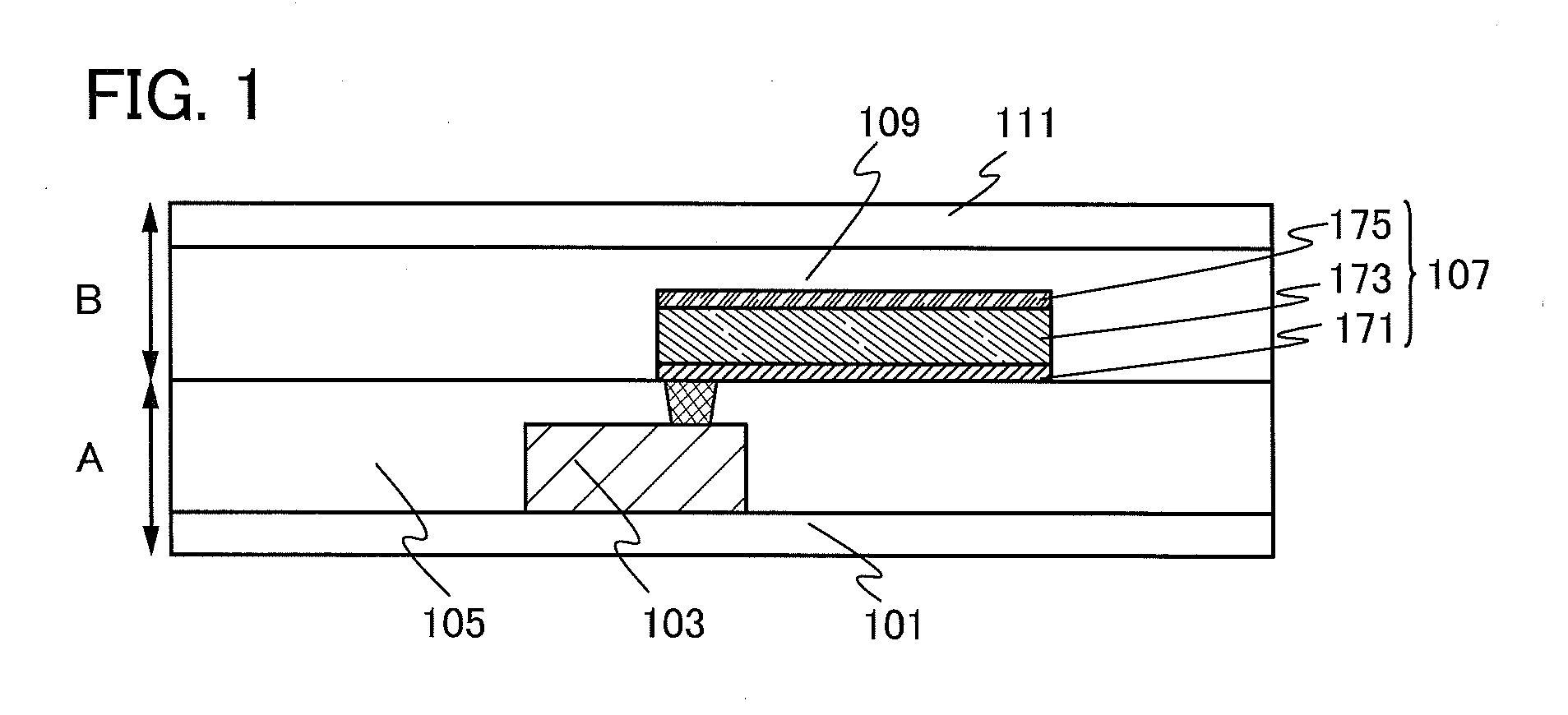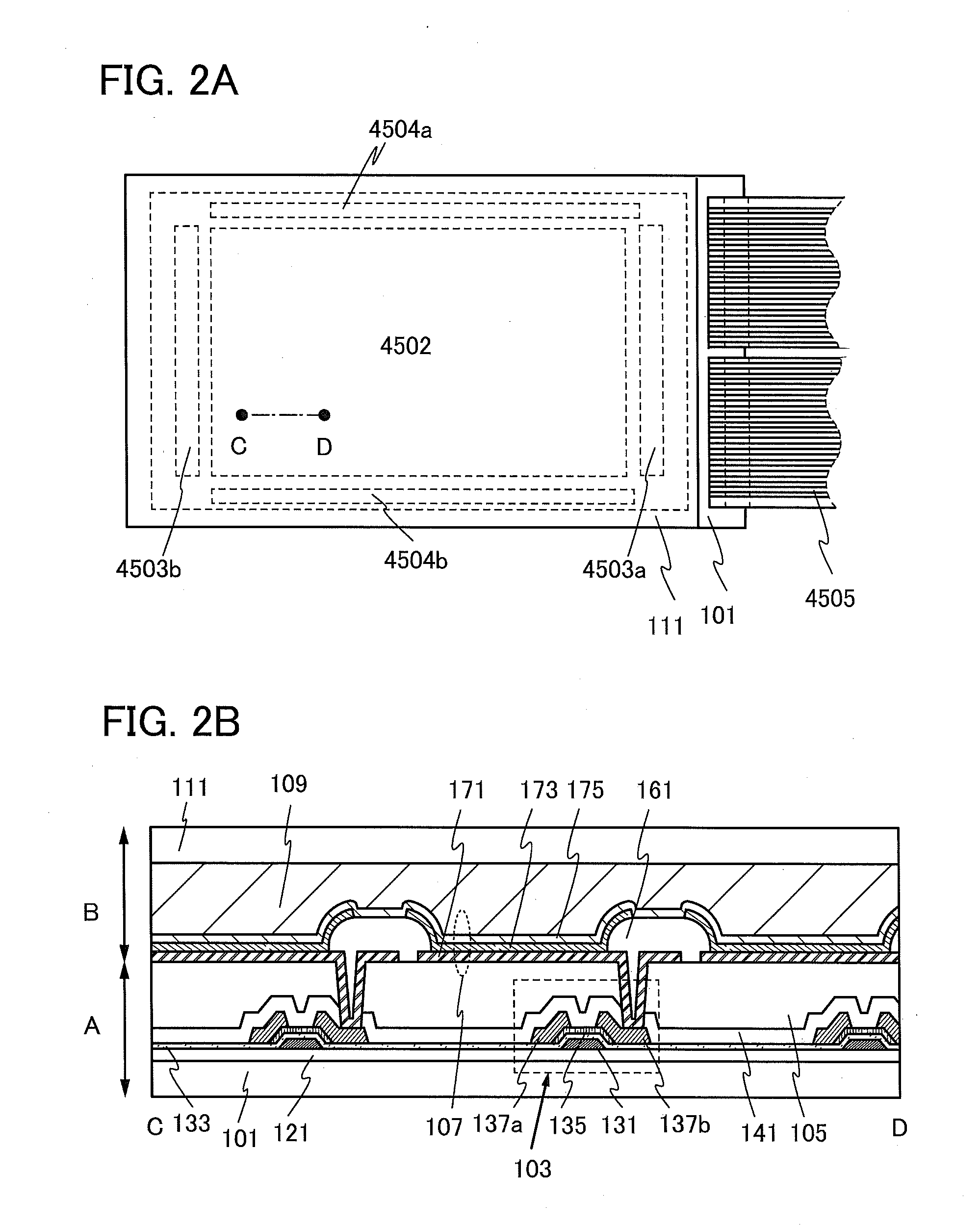Light-Emitting Device and Electronic Device
a technology of light-emitting devices and electronic devices, which is applied in the direction of electroluminescent light sources, thermoelectric devices, electric lighting sources, etc., can solve the problems of damage to the transistor or the organic el element due to bending or curving, damage to the display defect of a light-emitting device, etc., and achieves high flexibility, high reliability of light-emitting devices, and suppression of damage to transistors or organic el elements due to bending or
- Summary
- Abstract
- Description
- Claims
- Application Information
AI Technical Summary
Benefits of technology
Problems solved by technology
Method used
Image
Examples
embodiment 1
[0080]In this embodiment, light-emitting devices of embodiments of the present invention will be described with reference to FIG. 1 and FIGS. 2A and 2B.
[0081]FIG. 1 is a schematic view of a light-emitting device of one embodiment of the present invention. The light-emitting device illustrated in FIG. 1 includes, between one surface of a first flexible substrate 101 and one surface of a second flexible substrate 111, a planarization layer 105, a transistor 103 provided on the one surface side of the planarization layer 105, an organic EL element 107 provided on the other surface side of the planarization layer 105, and an adhesive layer 109 for bonding the first flexible substrate 101 and the second flexible substrate 111 with the transistor 103, the planarization layer 105, and the organic EL element 107 are provided therebetween. The organic EL element 107 is provided on and in contact with the other surface of the planarization layer 105, and includes a first electrode 171 electri...
embodiment 2
[0120]In this embodiment, a light-emitting device of one embodiment of the present invention will be described with reference to FIGS. 3A and 3B, FIGS. 4A and 4B, FIGS. 5A to 5E, and FIGS. 6A to 6E.
[0121]The light-emitting device of this embodiment is manufactured by a technique in which an element such as a transistor is manufactured over a formation substrate, and then the element is transferred from the formation substrate to a flexible substrate.
[0122]FIGS. 3A and 3B illustrate an example of a specific structure of a light-emitting device to which one embodiment of the present invention is applied. FIG. 3A is a plan view of a light-emitting device of one embodiment of the present invention. The light-emitting device illustrated in FIG. 3A includes the pixel portion 4502, a signal line driver circuit 4503, a scan line driver circuit 4504, and the FPC 4505. FIG. 3B is a cross-sectional view taken along an alternate long and short dash line E-F in FIG. 3A.
[0123]The light-emitting d...
embodiment 3
[0184]In this embodiment, a light-emitting device of one embodiment of the present invention will be described with reference to FIG. 7, FIG. 8, and FIG. 9.
[0185]FIG. 7 is a schematic cross-sectional view of a light-emitting device 400 described as an example in this embodiment.
[0186]The light-emitting device 400 includes an element layer 420 including a light-emitting element 410 provided over the substrate 401, a first protection layer 411 covering the element layer 420, and a second protection layer 412 provided over the first protection layer 411.
[0187]The substrate 401 has flexibility. The light-emitting element 410 is formed over an insulating surface of the substrate 401.
[0188]The light-emitting element 410 is a stack in which a first electrode 403, an EL layer 405, and a second electrode 407 are stacked in this order over the substrate 401. The EL layer 405 includes at least a light-emitting organic compound. At least one of the first electrode 403 and the second electrode 4...
PUM
 Login to View More
Login to View More Abstract
Description
Claims
Application Information
 Login to View More
Login to View More - R&D
- Intellectual Property
- Life Sciences
- Materials
- Tech Scout
- Unparalleled Data Quality
- Higher Quality Content
- 60% Fewer Hallucinations
Browse by: Latest US Patents, China's latest patents, Technical Efficacy Thesaurus, Application Domain, Technology Topic, Popular Technical Reports.
© 2025 PatSnap. All rights reserved.Legal|Privacy policy|Modern Slavery Act Transparency Statement|Sitemap|About US| Contact US: help@patsnap.com



